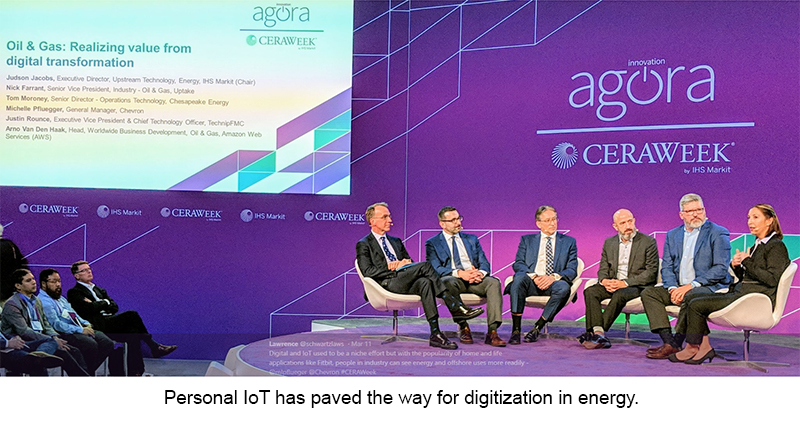I was able to do some live tweets from the show here. To further articulate some of the key challenges addressed:
Embracing Disruption – Having a Healthy Disrespect for the Impossible
Throughout the conference, speakers shared examples of how profound changes to the way businesses operate have already transformed many industries. Darryl Willis, VP Energy for Google Cloud, said the energy industry needs the same type of disruption that has happened in other industries such as music, transportation and retail. In fact, he compared seismic data to parallels in healthcare such as MRIs, and supply chain to parallels in retail places like Starbucks. Google is trying to intersect this need for disruption with what their company can do to help make energy more efficient and more accessible to the world. He noted that areas like natural language and machine learning have all been developed and deployed inside Google, and now can be applied in other areas like energy. He also notes a future where fast beats big, openness beats closed, and doing it alone is replaced by partnerships.
Adoption of new digital technologies is also accelerating. Andy Jassy, CEO of AWS, noted that it is not a matter of 'if', but 'when.' Financial, healthcare and energy have been conservative around cloud in the past, but the last 18-24 months have seen a strong trajectory to the cloud. Meanwhile, Michelle Pflueger, General Manager, Digital Innovation and Acceleration of Chevron, noted that digital and IoT used to be a niche effort but with the popularity of home and life applications like Fitbit, people in industry can see energy and offshore uses more readily. Below, Michelle speaks on a panel about digital transformation in oil & gas.

Reducing Impact on the Environment and Improving Sustainability
Equinor’s SVP of Sustainability Bjørn Otto Sverdrup called out two ways to provide energy while reducing the carbon footprint. He suggested reducing emissions from operations, including measuring how much carbon dioxide is created per unit of energy (similar to a mpg metric). He also spoke to the growth of renewables, such as offshore wind, pointing out that some windmills are now the size of the Eiffel Tower, making this alternative a more viable option than in the past.
Leaders from Dow, Pepsi, LyondellBasell and the American Chemistry Council discussed the sense of urgency around innovating in reuse and recycling of plastics. Increasing pressure from governments, especially in Europe, the UK and India, are driving companies to reassess their environmental impact. Dow’s Mike Witt, Corporate Director of Health Services, Research and Consulting, noted four key approaches to reduce plastic waste: innovation, infrastructure, cleanup and education. He also pointed to new uses – options like plastic roads or dense building blocks to create schools.
As an example, in one day a school in Colombia was built with these dense building blocks consuming four metric tons of plastic. Other examples of improvements on the horizon around full circular recycling are looking at how to break down plastics to the molecular level for flexible reuse. In a later panel, Dow’s CEO Jim Fitterling outlined how the aluminum can business also eventually overcame challenges around recycling with the right technologies and business models. He also noted that if food waste was a country today, it would be the biggest greenhouse emitter of gasses behind the U.S. and China. Effective use of plastics can dramatically increase the shelf life of foods.
Harnessing Information and Data
When different organizations rely on data and information, inefficiencies and even disagreements can arise. Especially in places like the supply chain, factors like a pervasive lack of planning, contracts that are hard to execute, and visibility that isn't real time lead to inefficiency according to Manas Satapathy, managing director of Accenture Strategy—Energy. Newer technologies like blockchain and smart contracts can provide much more transparency on transactions and triggers for agreed-upon terms.
Meanwhile, in a leadership dialogue, Chevron CEO Mike Wirth described how tens of thousands of wells lead to data lakes with tens of millions of data points, which fuel AI and machine learning. The ability to bring these technologies and other digital tools to bear creates opportunities to drive efficiency and performance. Ahmed Hashmi, Chief Digital and Technology Officer, Upstream, BP plc also stressed that the fundamentals, such as good visualization, can get you 70 percent of the way to leveraging more with data, easing the onramp into the digital world.
Want to explore disruption and digital acceleration in more depth? Register for OPTIMIZE 2019.






Leave A Comment